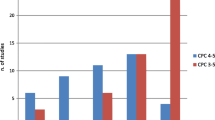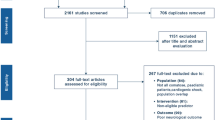Summary
In a prospective clinical trial we investigated the predictive value of clinical, neurobiochemical and electrophysiological markers of brain damage in comatose patients who survived cardiac arrest. From 1997 to 1999 we included 69 consecutive patients, 21 women and 48 men with a mean age of 64 years (17–90 years). Twenty-eight days after cardiopulmonary resuscitation (CPR) 57% of the patients had died. Forty-three percent of the survivors developed a persistent vegetative state. Results: The following predictors of an individual poor cerebral outcome (death or persistent vegetative state) were found: 1. Persistence of unconsciousness longer than 48 hours. 2.A serum level of the neuron-specific enolase (NSE) above 30ng/ml and/or a serum level of Protein S-100 (S 100) above 0.7 μg/l – in the first five days after CPR, respectively. 3. The bilateral absence of middle long latency somatosensory evoked potentials (SSEP). In comparison to determination of short-latency SSEP (N20) only, the recording of the middle-long SSEP (N70) was more sensitive in detecting patients with poor outcome (see above). Conclusion: In addition to routine clinical and neurological examination, early recording of middle long latency SSEP and the measurement of the serum-levels of NSE or S 100 over a five-day period after CPR are recommended as objective markers of a poor cerebral outcome.
Zusammenfassung
In einer prospektiven klinischen Studie wurde der prognostische Vorhersagewert klinischer, laborchemischer und elektrophysiologischer Untersuchungsparameter bei komatösen Patienten nach kardiopulmonaler Reanimation evaluiert. Von 1997–1999 wurden 69Patienten, 21 Frauen und 48Männer, mittleres Alter 64 (17–90) Jahre eingeschlossen. 28Tage nach Reanimation waren 56,6% der Patienten verstorben, 43% der Überlebenden entwickelten ein apallisches Syndrom. Ergebnisse: Das Fortbestehen einer komatösen Bewusstseinslage über 48 Stunden nach Reanimation, persistierend hohe Serumkonzentrationen der Neuroproteine Neuronenspezifische Enolase (>30 ng/ml) und Sangtec 100 (>0,7 μg/l) und das Fehlen kortikaler Komplexe mittlerer Latenz (N70) bei Ableitung der Medianus-SEP zeigten mit hoher Spezifität und Sensitivität frühzeitig eine individuell schlechte Prognose – Tod oder apallisches Syndrom – an. Dabei erwiesen sich die kortikalen Komplexe mittlerer Latenz allen anderen Parametern überlegen. Schlussfolgerung: Die Autoren empfehlen für die Prognosebeurteilung komatöser reanimierter Patienten auf der Intensivstation neben der täglichen klinisch-neurologischen Untersuchung die Ableitung der Medianus-SEP, und hier insbesondere der kortikalen Komplexe mittlerer Latenz sowie die Bestimmung der Serumkonzentration eines Neuroproteins NSE oder S 100 über einen Zeitraum von 5 Tagen nach Reanimation.
Similar content being viewed by others
Author information
Authors and Affiliations
Additional information
Eingegangen: 3. Juli 2000 Akzeptiert: 6. November 2000
Rights and permissions
About this article
Cite this article
Pfeifer, R., Reinecker, B., Wiederhold, C. et al. Individuelle Prognose nach kardiopulmonaler Reanimation – ist eine frühe Vorhersage möglich?. Intensivmed 38, 15–25 (2001). https://doi.org/10.1007/s003900170105
Issue Date:
DOI: https://doi.org/10.1007/s003900170105




